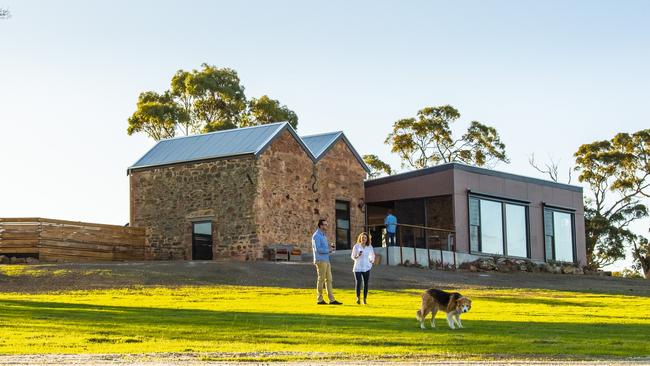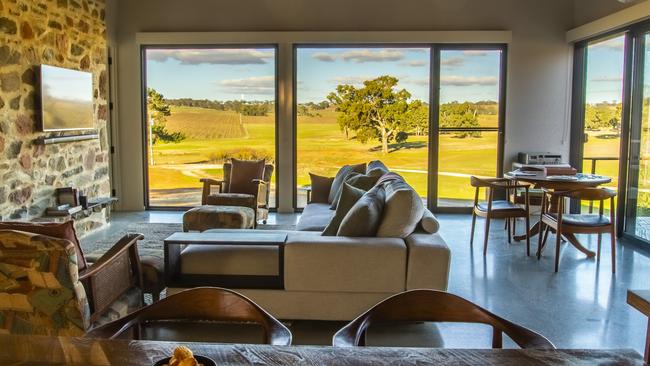Vino Camino: the path to food and wine enlightenment
The Vino Camino is only a few kilometres - and the God we seekmust be Dionysus, given the frequent breaks for fine food and wine.

Stephen Henschke is standing atop South Australia’s Mount Edelstone from where the Cinemascope view sweeps across the Eden and Barossa Valleys to distant ranges stretching north to the ancient Flinders. The fifth-generation winemaker is discussing provenance and antiquity, the impossible age of those worn hills and Henschke’s “grandfather” shiraz vines, among the oldest in the world, at nearby Hill of Grace. Down below, planted in rich clay-loam before the Great War, the Mount Edelstone vineyard shimmers like scattered gold coin.
Our little group has scaled – well let’s be honest, we’ve strolled up – Mount Edelstone. Sweat has not been broken. Yet sustenance is in the offing for we are following the annual Vino Camino, a Tasting Australia signature event, through vineyards and paddocks linking the properties of two prominent settler families. Their descendants Stephen and Prue Henschke and John and Jan Angas walk with us.

On the hilltop we are greeted by an old red tractor that might also date from before the Great War. It’s hitched to a flatbed trailer arrayed with bottles of shiraz including Henschke’s flagship Mount Edelstone and Hill of Grace. A century-old campaign oven warms little mushroom pithiviers and kangaroo bao buns.
Our camino is no more than a few kilometres and the God we seek must be Dionysus for there are frequent breaks for fine food and wine and, for those feeling the burn, shortcuts on the back of old farm trucks cheerily decorated with Turkish rugs. At the lovely and remote Gnadenberg church (where parishioners are treated to altar wine by the Henschkes) bubbles are popped before we stroll up the road to commune with the legendary Hill of Grace vines.
Viticulturalist Prue Henschke gently manages these ancient dry-grown beauties, gnarled and twisted like lumpy pretzels, deploying organic and biodynamic principles. Because of their great age and geographical isolation (disease put paid to many old vines in Europe) they claim a unique genetic heritage and constitute a living museum.

Crossing onto Hutton Vale Farm, sixth-generation John Angas and his wife Jan take up the story. The farm was founded by John Howard Angas in 1843, son of George Fife who sponsored the Valley’s first Silesian settlers; nearby Angaston bears his name. This beautiful property has real soul; sentinel red gums circumscribe old stone stables and barns where rusted ephemera has been transformed into sculptures and quirky installations. A traditional Barossa “mixed farm”, Hutton Vale also makes wine. John’s grandfather Ronald planted the Mount Edelstone vineyard before Cyril Henschke began taking fruit in the ’50s. The 65th consecutive single-vineyard vintage was released last month and it’s a cracker.

All along the camino we sample Barossa specialities: lachsschinken pie made with dry-cured pork loin, quince tart, apricot pretzel twists. And other treats: strolling into an otherwise empty valley, our appetites sharpened by the churchyard bubbles, we spy Barossa chef Mark McNamara standing over a wine barrel shucking Coffin Bay oysters. “History suggests I should be serving Angasi,” says Mark, “but the season is very short.” (Australia’s native mud oyster is named for another Angas ancestor, George French Angas, artist and keen malacologist.)
We end our walk with a long-table lunch beneath a beautiful vine arbour in the walled courtyard of the farm’s old barn and stables. Jan has suspended great garlands of pomegranates from the garden above a table festooned with bottles of wine. Braziers are lit, chef Mark tends slow-cooked farm lamb, wine and yarns flow. As the sun draws down, flocks of galahs blaze across a pink sky and sheep dogs nap under the table. I cannot remember a lovelier day.
The good news is travellers are welcome to stay anytime at Hutton Vale in the farm’s wonderful old JHA Stone Cellar. Handsomely refurbished, the two-bedroom retreat commands long farm and vineyard views and comes with its own vegie patch and chef’s kitchen, perfect for whipping up breakfast with farm eggs, homemade jams and Barossa sourdough. The living area is dominated by an impressive stone wall with log fire (set and ready to strike) and squishy sofa with throws fashioned from farm wool. Nothing has been overlooked from the underfloor heating (winters are chilly) to the piles of books and bottles of house wine. It makes the perfect Barossa base.
• Perfect for: Oenophiles, food lovers.
• Must do: Tutored wine tastings in the old Hutton Vale stables and at the nearby Henschke cellar door.
• Dining: In Angaston, check out Casa Carboni enoteca and the excellent new Otherness wine bar.
• Getting there: Henschke and Hutton Vale Farm are near Angaston, about 90 minutes from downtown Adelaide.
• Bottom line: Vino Camino (from $375 per person) is part of the annual Tasting Australia festival, returning April 28 to May 7, 2023; check for updates at tastingaustralia.com.au or email events@henschke.com.au. JHA Stone Cellar, Hutton Vale Farm is suitable for two couples (booking together) or a family of four. From $490 per night for one bedroom, $690 per night for both; minimum two nights. Breakfast provisions included.
huttonvale.com; henschke.com.au



To join the conversation, please log in. Don't have an account? Register
Join the conversation, you are commenting as Logout